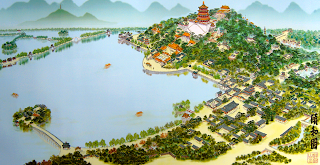China - Summer Palace
The Summer Palace was built around 1100AD after the Imperial capital was moved to Beijing. Although its only about 40mins (with no traffic) outside the city center today, it was considered the pastoral countryside at the time of its construction. The grounds consists of a huge lake along the shore of the 200-foot high Longevity Hill. What's fascinating about the lake is it is entirely man-made, dug by hand and excavated by ox-pulled carts. The purpose of this was two-fold: built a magnificent lake, and use the earth to construct a 200 foot hill upon which to build a castle.
Notice a difference in the photo above and below? Pollution is a huge issue in Beijing. Shame that such a beautiful location is so dulled by the smog.
The Summer Palace has fallen prey to two acts of major destruction. The first took place in 1860 when the Anglo-French forces invaded Beijing. In 1888, Empress Dowager Cixi (AKA the Dragon Lady) diverted 30 million taels of silver originally designated for the Chinese navy into the reconstruction and enlargement of the Summer Palace.
The second great act of destruction took place in 1900 when the Eight-Power Allied Forces invaded Beijing. The great temples rebuilt in the 1880s were completely demolished and almost every valuable object in sight stolen by the invading troops. In 1902, when Empress Dowager Cixi returned to Beijing from Xi' an, she ordered the reconstruction of the park. According to historical records, she "rebuilt the Summer Palace with unbounded extravagance and opulence, spending some 40,000 taels of silver per day.
Just past the lake you enter the inner grounds of the Palace. The gardens here are decorated with enormous boulders, that were gifts to the Emperor. Its said the donor went bankrupt expending all his resources to move these giant rocks to the palace. As a result, its ok to photograph the rock (in photo below), but one should never be photographed with the rock or you too will suffer the same fate.
Old man writing beautiful Chinese characters in water on the sidewalk.
The magnificent Long Corridor is 728 metres in length (was listed in the Guinness book of world record as the longest corridor in the world).
The Long Corridor is richly decorated with 14,000 paintings. The paintings depict historical and legendary figures from folk tales, episodes from Chinese classical literature, as well as traditional classical landscapes with birds, fish, flowers and all the beauty of nature. They are quite astonishing in their brilliance of color, detail and design.
The photos above and below give a glimpse of the scale of the corridor.
The Marble Boat













So interesting and great pics too!